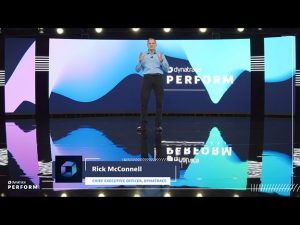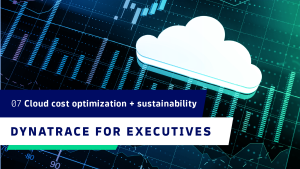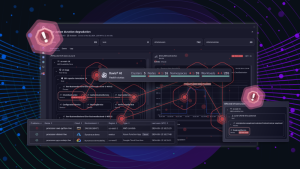At this year’s Perform, CEO Rick McConnell and CMO Mike Maciag unpack the power of modern observability and AIOps as organizations traverse digital transformation.

Today, businesses are racing ever faster to accommodate customer demands and innovate without sacrificing product quality or security.
“Organizations are accelerating movement to the cloud, resulting in complex combinations of hybrid, multicloud [architecture],” said Rick McConnell, Dynatrace chief executive officer at the annual Perform conference in Las Vegas this week. “They bring a scale and complexity that is well beyond that of the data center world and it isn’t manageable manually.”
The demands of digital transformation can create a difficult tightrope for organizations to walk. As they increase the speed of product innovation and software development, organizations have an increasing number of applications, microservices and cloud infrastructure to manage. That ushers in IT complexity.
COVID-19 has accelerated the benefits—and downsides—of digital transformation. In 2021, Deloitte reported that 77% of CEOs stated that the COVID-19 pandemic has accelerated their digital transformation plans.
Further, many organizations—more than 90%—have turned to cloud computing to navigate the highwire act of balancing speed and quality. But as they turn to cloud environments to develop new products and manage IT infrastructure, they have introduced a host of complex systems that need to be managed and secured. For these vast environments, traditional, manual methods no longer suffice.
McConnell noted that the audience of “game changers”–engineers, developers, cloud architects and other IT managers–have their hands full as these environments grow and increase in complexity.
“We know your job has never been more difficult or challenging,” McConnell said. IT practitioners need a platform that can alleviate some of this burden through modern, end-to-end observability and automated problem remediation.
Why modern observability is the onramp to digital transformation
To innovate faster, at scale and more securely, organizations have come to recognize that they need the right kinds of tools to shepherd digital transformation. As a result, modern observability has become a key technology to enable enterprise success as companies digitally transform.
Unlike traditional monitoring, a modern observability platform provides precise data in real-time about the root cause of application issues. And it is fueled by AIOps, or artificial intelligence for IT operations, which provides contextualized data—without the time-consuming need to train data with machine learning.
Consider a true self-driving car as an example of how this software intelligence works. A self-driving car needs real-time insight in order not to collide with other cars or cause bodily harm. This contextual insight is akin to how modern observability operates.
“A truly self-driving car constantly and continuously senses its environment,” said Mike Maciag, chief marketing officer, at Perform 2022. “Every other car, every road sign, every pedestrian, every stray ball and much more. It would also need to think about all this input through AI and make decisions in real time with precise accuracy,” Maciag said.
The self-driving car enlists three phases of data ingestion and analysis to generate contextual, real-time insights, then generate informed insight.
The three components of modern observability
“Modern observability involves taking in data inputs, analyzing that data, then acting with precision on that information,” Maciag explained. “It starts with deep and broad observability. We gather logs, metrics and traces. We go further to include distributed tracing, code-level detail, user experience, and even behavioral data. All in one place, all in context, and all tied wo what it means for your business.”
Let’s explore how these three components of observability work.
- Sensing. Sensing starts with Dynatrace OneAgent. Because dynamic elements in multicloud environments are always spinning up and down, manual efforts can’t keep up. With OneAgent, there is no need to configure or script. Getting the data is all automatic with no wasted time and no wasted resources, so teams can focus on what matters: innovation. OneAgent continuously self-discovers what’s new and incorporates it into the whole. With open APIs, OneAgent can collect even more sources of data for the platform to consume.
- Thinking. With the data collected, Dynatrace PurePath technology automatically captures and analyzes transactions end-to-end with no code changes from the browser to the code to the database. Dynatrace Smartscape automatically builds and continuously maintains a real-time topology map of how everything works including millions to billions of dependencies. With real-time context from Smartscape, the Dynatrace Davis AI engine provides automatic analysis for precise answers, including root-cause analysis, anomaly detection, and business impact analysis. This precision reduces wasted motion and accelerates response times. With its causation-based approach, Davis AI doesn’t need to learn and doesn’t make guesses. It knows the impact of problems, suppresses noise, and provides precise root causes.
- Acting. Put together, the Dynatrace Software Intelligence platform provides teams across the organization with actionable answers. DevSecOps teams can take automated action to increase speed and improve the quality of innovation, the effectiveness of operations, and the security of apps. Teams can resolve issues within minutes before end-users are affected. Instead of being tied up in war rooms, teams can focus on innovation, optimize user experiences, and optimize business outcomes.
Ultimately, as McConnell noted, organizations are charging forward into their future with digital transformation. But they need help to do so securely and at scale.
“Digital transformation at scale requires assistance,” McConnell said. “You need automatic and intelligent observability spanning your applications, infrastructure, and user experience. You also need a solution that continuously maps, analyzes and optimizes the apps, microservices and interdependencies across hybrid and multicloud [architecture]. You need precise answers, not statistical guesses.”
For our complete Perform 2022 conference coverage, check out our guide.





Looking for answers?
Start a new discussion or ask for help in our Q&A forum.
Go to forum